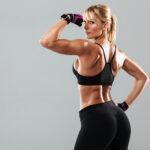Bent-Over Barbell Row: Exercise Overview
The bent-over barbell row is a cornerstone compound exercise renowned for its ability to build and strengthen the muscles of the upper back, including the latissimus dorsi, rhomboids, and trapezius. It also engages the biceps, posterior deltoids, lower back, and core as stabilizing muscles, making it a highly effective movement for comprehensive back development.
Widely used by bodybuilders to sculpt a muscular back, powerlifters to enhance strength for the “big three” lifts (squat, bench press, deadlift), and athletes to improve pulling power, the bent-over row is a versatile staple. Its adaptability through variations and grip adjustments allows lifters to target different back muscles and accommodate individual biomechanics. This exercise fits seamlessly into back workouts, upper-body sessions, pull routines, or full-body training programs (Schoenfeld, 2010).
Variations:
- One-Arm Dumbbell Bent-Over Row
- Reverse-Grip Bent-Over Row
- T-Bar Row
How to Perform the Bent-Over Barbell Row
- Stand with feet hip-width apart, holding a barbell with a double overhand grip, hands slightly wider than shoulder-width.
- Hinge at your hips, pushing them back until your torso is nearly parallel to the floor or slightly above, maintaining a slight bend in your knees.
- Engage your core to keep your spine neutral—this is your starting position.
- Initiate the movement by driving your elbows back and retracting your shoulder blades, pulling the barbell toward your lower chest or upper abdomen.
- Pause briefly when the bar touches your body, squeezing your back muscles for maximum contraction.
- Lower the barbell back to the starting position with control, keeping it close to your body.
- Repeat for the desired number of repetitions.
Tips for Optimal Performance
- Maintain a Neutral Spine: Keep your core braced and back straight to avoid rounding or over-arching, which reduces spinal stress and enhances back engagement (McGill, 2010).
- Control the Movement: Perform the pull and descent slowly to maximize muscle activation and prevent momentum, which improves effectiveness and reduces injury risk (Schoenfeld, 2016).
- Adjust Head Position: Experiment with a neutral neck (chin tucked) or slightly forward gaze to find what feels best for your posture and comfort (Wirth et al., 2016).
- Allow Shoulder Blade Movement: Let your shoulder blades retract as you pull and protract slightly as you lower to optimize lat and rhomboid activation, avoiding locked scapulae.
- Avoid Head Jutting: Keep your head aligned with your spine to prevent neck strain during the pull.
- Experiment with Grip and Angle: Vary grip width (e.g., wider for lats, narrower for rhomboids) or torso angle to target different back muscles and suit your biomechanics.
- Breathe Properly: Inhale as you lower the bar and exhale as you pull to support core stability and muscle oxygenation.
Building back strength with barbell rows? See their place in our Ultimate Guide to Muscle Groups for a powerful back.






